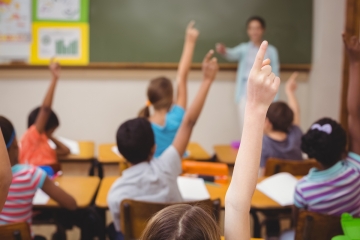Editor’s note: This is an edition of “Advance,” a newsletter from the Thomas B. Fordham Institute written by Brandon Wright, our Editorial Director, and published every other week. Its purpose is to monitor the progress of gifted education in America, including legal and legislative developments, policy and leadership changes, emerging research, grassroots efforts, and more. You can subscribe on the Fordham Institute website and the newsletter’s Substack.
We in education reform are often guilty of focusing too much on theory and ideology and too little on the real-world experiences of teachers. Gifted education is no exception. Fights over equity and excellence are important, but so too is figuring out the nuts-and-bolts details of how to make stuff work. Where programs and services exist, for example, school systems often staff them in haphazard ways—assuming, it seems, that any educator can teach these students adequately. If special training is offered, it’s frequently flimsy. Many times, there’s none at all. And even in places that avoid these mistakes, curriculum and instruction can be afterthoughts. The victims in all of this, of course, are the students, whose achievement and potential are blunted by bad policy.
To learn more about these issues from the perspective of a teacher, and to better understand what leading a gifted classroom is truly like, I spoke with Janet Kragen. Residing in Washington State, Janet just retired in June after teaching for forty-three years, specializing in gifted education since 1983. She also served for more than a decade on the board of the Washington Association of Educators of Talented and Gifted. And for years, she’s contributed to Stories from School, mostly writing about gifted topics.
What made you want to teach gifted students?
In my first couple of teaching jobs, people would come into my classroom, see the way I was teaching, and say, “You should be teaching gifted kids.” They never seemed to comment on the fact that I was getting nonreaders in fourth grade to read chapter books. But they were blown away by the other reading group in the room, reading Shakespeare with me.
In 1977 or ‘78, I remember a girl didn’t understand a math problem. This was back in the days when we typically taught algorithms from the book. I abandoned the lesson and explained the problem in an entirely different way. She looked at me cockeyed and asked, “Well, why didn’t you say that in the first place?” My principal got a chuckle out of that story, but that was another time I heard I should be teaching gifted.
After four years in private schools, I got a job teaching writing in a public middle school in upstate New York. The principal came to me after several weeks and asked if I would teach a class for gifted. I said yes. I was a long-term sub at the school, I had no experience teaching gifted, and I had no training in gifted education. In spite of being a complete neophyte, I got to design the program, identify the students, and teach the class.
I decided to create a school journal. (I was a writing teacher, after all.) At the middle school, we focused on business letters, report writing, and persuasive essays. I wanted students to have a creative outlet.
The principal gave me a list of students who had scored well on tests. I asked those students if they were interested in joining the group. Some did. Then I went to the English teachers. I said, “Never mind test scores. Who in your class is really talented in writing?” I asked those students if they wanted to join the group and some of them did. After we put out several issues of the journal, I included an ad saying that any interested student could join the class. Half a dozen or so showed up to the next meeting. All but one dropped out immediately saying it was too much work. One boy I’ll call Jack stayed and wrote a great short story. I remember his teacher coming up to me afterwards and saying, “I never knew he had it in him.”
I called the program GTM—Gifted/Talented/Motivated.
It’s still my philosophy for including kids.
What was the most challenging part of teaching gifted students? How did that differ compared to their peers who weren’t identified for gifted programs?
Over the years I discovered that half my job was teaching academics. And half was helping my students with their social and emotional needs. In the first week of every school year, I talked with my students about insomnia, which is a characteristic problem for the gifted. We would share tips for how to get to sleep. I would discuss perfectionism and anxiety repeatedly each year, with individuals, with families, or with the whole class.
Often times gifted kids are highly verbal, so there is a lot of talking and hands eagerly raised and interrupting. As a teacher, you need to manage that enthusiasm, especially when you consider that many gifted individuals are introverts who need quiet to process their thinking. I found that little of the blurting out and interrupting was actually disruptive. It was all on topic. The students were very engaged. They just didn’t have a lot of self-control. Nevertheless, I needed to preserve pockets of stillness for all the introverts.
Gifted kids often assume they know how to do things. They think if they can’t figure it out, they aren’t as smart as they thought they were. They don’t like to ask for help. I modeled on a daily basis that it was OK to make mistakes and get help, including from the kids in the class.
Gifted kids often assume they are right. It can make discussions fraught when individuals take opposing positions. I finally required an exit ticket for one type of literary discussion. Students had to write on a 3x5 card the answer to two questions: What did you learn from someone else’s comments? How did someone change your mind? That second question changed everything, I think because it actually gave them permission to change their mind.
I did teach some general education classes. Here are some differences I found:
- With my gifted classes, I had to go a lot faster and do a lot more. (If you don’t keep gifted kids productively engaged, they turn that energy into amusing themselves. Sometimes that’s fine, and sometimes it really isn’t.)
- In a gen ed class, I found it difficult to start and maintain a class discussion. That was never a problem in my gifted classes.
- The gifted kids liked my sense of humor. They got my jokes. (For that matter, they got each other’s jokes.)
There are currently efforts around the country, efforts that are long overdue, to identify more marginalized students for gifted programming and to better serve them—students who are Black, Hispanic, low-income, and from other marginalized backgrounds. What could Washington State and others states around the country do differently to better diversify gifted education?
What’s the biggest difference between kids entering school from rich neighborhoods and poor neighborhoods? Children in high-income families hear 30 million more words than children in low-income families by age three. My question is, how can we get child care workers and preschool teachers and babysitters and parents to talk intentionally to their babies and toddlers a whole lot more? Wouldn’t it be amazing to improve all children’s verbal skills before they arrived at school? We would surely pull a more diverse clientele into our gifted programs.
But what can districts do right now? First of all, each district should screen for the type of services they will provide. Are they going to have a highly academic program? Will they focus on developing creativity? Or will they do both?
Then districts should use a universal screening tool to help identify students, like the Cogat or the NNAT3 Naglieri Nonverbal Ability Test. Teacher and parent referrals can provide additional input for the evaluation team, but referrals should never be the gateway for assessment. Districts ought to have multiple criteria so no single test gets a student identified or disqualified.
Then there’s the possibility of using local norms instead of national standards. For example, your district could say, “We’re going to serve the top 5 percent from each school in the district in our program.” The top 5 percent from one neighborhood might have higher test scores than the top 5 percent from another neighborhood. Using local norms gives every school equal opportunity and equal representation.
Finally, remember Jack? No test identified him. No teacher noticed him. He came to my class and asked to be let in. I think we not only need to be open to self-nomination, we need to advertise. Students who want to dive in the deep end of the pool should be welcome to give it a shot. There’s no harm in allowing children to attempt challenging things.
Let’s change gears now and talk about your professional training for teaching gifted students. How did that work?
I took university classes. I also took classes through my district (the North Kitsap School District), a regional consortium of districts, and Washington’s Office of Superintendent of Public Instruction (OSPI). In addition, I attended years of conferences put on by the Washington Association of Educators of Talented and Gifted (WAETAG). All told, it amounted to a couple dozen quarter units over thirty-five years. When I started out, I took all the classes I could find, so that gives you a sense of how few classes were offered. It’s definitely better now.
It was all haphazard and self-directed. Luckily, my first foray into gifted coursework, Beyond the Classroom, was excellent. The instructors pushed us to see that our job extended into community outreach and advocacy. Roger Taylor honed my skills in integration. Lisa Van Gemert inspired me to find new ways to meet the emotional needs of my kids. Multiple WAETAG speakers gave me tools that helped me in my classroom, and the conferences energized me every year.
Do you think that’s a good system? What do you wish the state and district would’ve done differently?
It’s a ridiculous system. Would you go for medical treatment from someone who skipped around from school to school, picking one class one year and one the next, with no organizational oversight, in order to qualify to work in a particular specialty?
I think that if a person is hired to teach gifted students full-time, they should be working toward their state’s certification in gifted. In Washington State, it’s possible to get a Master of Arts in Teaching in gifted education and equitable instruction or a Master in Education with a gifted education track. (Those options were not available until long after I earned my MA.)
If a person is assigned a cluster of gifted students in their gen ed classroom, they should take gifted coursework, too, even if it’s just on how to differentiate and how to meet the social and emotional needs of those unique students.
More generally, teacher quality and expertise are among the less-talked-about aspects of gifted education, at least from a policy perspective. Can you speak on that? How big of a problem is that, and how should school systems handle training and selecting teachers for these programs?
We all know the bias that claims gifted students don’t need any educational support. They can do fine on their own. We all know that isn’t true.
In much the same way, there seems to be the assumption that, since gifted students are smart, anyone can teach them. That also isn’t true.
Not everyone can teach music or P.E. or kindergarten or calculus. Trust me, you don’t want me teaching any of those classes. But I’m good at teaching gifted.
You don’t have to be smarter than the kids you teach in a gifted class. Plenty of times you won’t be. But you have to be quick-witted. You have to like these kids, with all their quirks. You have to understand asynchronicity and how a kid can have the intellectual capacity of a fifteen-year-old but the maturity of a five-year-old. In fifth grade. You have to know how to manage and care for twice-exceptional (2-E) kids, plus high-anxiety kids and the kids whose drive for perfection sabotages their ability to achieve mere success.
It can’t just be anyone who has room in their schedule.
By the way, if a teacher consistently has multiple behavior problems with gifted students, especially year after year, that teacher might not be a good fit with that group of students.
Given your decades of first-hand experience, what’s your overall assessment of gifted education today? And what’s your hope for what it can and ought to be in the future?
Once school got out this June, I started looking at state requirements for gifted education. I’ve read through the regulations for about ten states so far. My overall impression is that most states have a requirement that districts provide gifted education services. However, most states provide little to no direction beyond that. They may give suggestions or recommendations for how to run programs, but ultimately, it’s up to districts. When I’ve investigated further, I’ve found some districts leave the decisions up to the individual schools!
It’s quite a contrast to the other side of the exceptional-children spectrum. I found that, in our state, the rules for special education take up 135 pages while the rules for gifted take up 8 pages. Not that I think we need over 100 pages of regulations, but I do think we need some guardrails and protections.
In my experience, I’ve found that programs flourish under supportive administrations. They can survive and even thrive under benign neglect as long as the staff is trained and experienced enough. But they can be eliminated or gutted almost overnight—even in the face of passionate parental and educator protests—if new administrators come in who are philosophically opposed to the very notion of gifted education.
I like that Illinois calls their law the Accelerated Placement Act. The law “requires Illinois public school districts to adopt and implement policies on acceleration that, at minimum, provide opportunities for early entrance to kindergarten and first grade, opportunities for accelerating a student in a single subject area, and opportunities for ‘whole grade’ acceleration (sometimes referred to as ‘grade skipping’).” The state establishes a minimum bar for the services parents can expect to receive for their child.
I love to see gifted students reading on their level and doing math on their level, not being tied to their grade level. I love to see them connecting with each other and finding they are not alone in the world. I love to see them realize they aren’t always the smartest person in the room and that humility isn’t a bad thing. I love to see them struggle and work hard and overcome failure and finally succeed. Then we do a happy dance together!
I want gifted kids to have what every kid should have: A challenging education that pushes them to do more than they thought they could. A chance to socialize with peers. A place where they feel safe and have fun and where they learn to make the world a better place. I want them to be successful in my classroom and beyond.
—
QUOTE OF NOTE
“‘I’m still a normal 13-year-old,’ said Alena, [who just got accepted to medical school, and who is] a student at both Arizona State University and Oakwood University, where she is simultaneously earning two separate undergraduate degrees in biological sciences. ‘I just have extremely good time management skills and I’m very disciplined.’”
—“Alena Analeigh Wicker, 13, just got accepted to medical school,” Washington Post, Sydney Page, July 20, 2022
—
THREE RECENT STUDIES TO STUDY
“Emotional Response to Testing in Gifted and Highly Gifted Children,” by Cesare Cornoldi, David Giofrè, Irene Cristina Mammarella, and Enrico Toffalini, Gifted Child Quarterly, Volume 66, Issue 3, 2022
“The present study examined the relationship between performance and emotional response in 468,423 Italian fifth-graders taking a national test on mathematics and language... The results showed that, although a lower emotional response correlated with a higher achievement, this relationship is nonlinear, and the estimates for gifted and highly gifted children were virtually the same. Girls showed a greater emotional response than boys on all levels of performance.”
“Will We Ever Close the Gender Gap Among Top Mathematics Achievers? Analysis of Recent Trends by Race in Advanced Placement (AP) Exams,” by A. Kadir Bahar, Journal for the Education of the Gifted, Volume 44, Issue 4, 2021
“Analyzing the test scores of more than 10,000,000 students who participated in the Advanced Placement (AP) math exams from 1997 to 2019, this study examined the direction and magnitude of the trend in gender disparity by race in participation in and top achievement on AP Calculus AB, Calculus BC, and Statistics exams. The results of this study indicated that, in general, females’ representation in all three AP exams increased significantly.”
“Identifying and Serving Gifted and Talented Students: Are Identification and Services Connected?” by E. Jean Gubbins, Del Siegle, Karen Ottone-Cross, D. Betsy McCoach, Susan Dulong Langley, Carolyn M. Callahan, Annalissa V. Brodersen, and Melanie Caughey, Gifted Child Quarterly, Volume 65, Issue 2, 2021
“The importance of alignment between identification processes and program design is widely noted in gifted and talented education literature. We analyzed publicly available district gifted program plans (grades 3–5) from two states to examine the extent to which district identification practices matched intervention strategies... The results of this study indicated that, at least in terms of planning, districts in the two states we examined appeared to be aligning identification and programming practices to meet the needs of gifted students identified in mathematics and/or reading/English language arts.”
—
WRITING WORTH READING
“Alena Analeigh Wicker, 13, just got accepted to medical school,” Washington Post, Sydney Page, July 20, 2022
“Science shows most high achievers had troubled childhoods. Elon Musk’s sister just explained why he's the perfect example,” Inc., Jessica Stillman, August 1, 2022
“The case of the missing data on AP students,” Education Week, Ileana Najarro and Eesha Pendharkar, July 29, 2022
“What to do if your school doesn’t offer AP Courses,” U.S. News, Cole Claybourn, July 28, 2022
“Back to school at Tempe Elementary: Gifted learning program opening at Arredondo,” Wrangler News, Wrangler News Staff, July 31, 2022
“Spanish students ace Advanced Placement,” Thousand Oaks Acorn, Dawn Megli, July 15, 2022
“Learning from Asian-American success,” City Journal, Neetu Arnold, June 30, 2022








